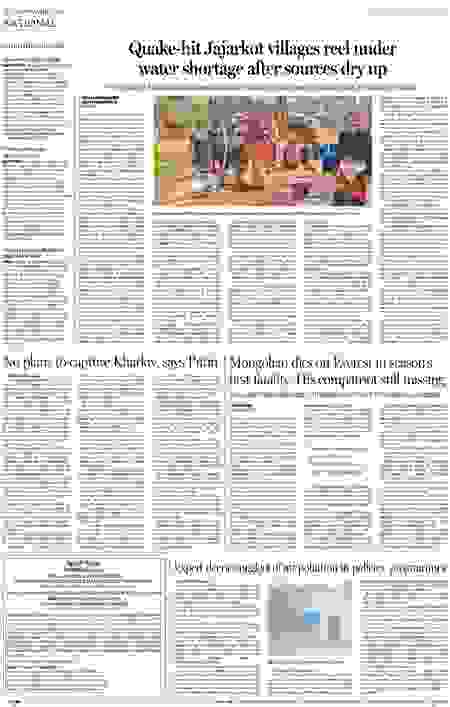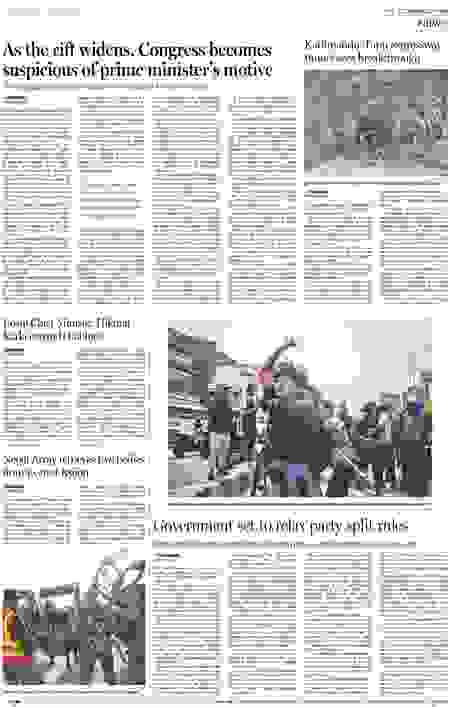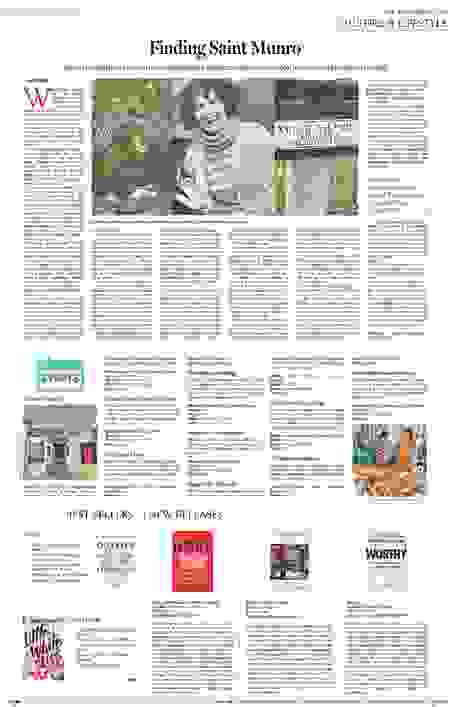CULTURE & LIFESTYLE
Capsule wardrobe: An answer to sustainable fashion
In a world inundated with endless choices, this fashion hack offers a refreshing alternative—a return to simplicity and mindful consumption.
- Samundra Gurung
One of the most frequent complaints that you hear from people while going out is that they say don’t have anything “nice” to wear. The term nice entails a variety of meanings, especially in the context where everything is captured digitally and archived, people want to look their very best all the time. We can’t help it—it’s a universal experience.
But when you go through your closet, it tells a different story. All the bundles of clothes piled up stare at you, some even stashed away in the corner, waiting to see the light of the day. You, however, are certain that anything in your closet is inappropriate for that specific event and decide to go on yet another impulsive casual shopping spree.
For most of us, clothing is the one item we spend more on because it is deeply personal. We are visual creatures, and fashion is a powerful medium for self-expression. It allows us to convey our personality, mood, and values through clothing and empowers us to curate our outward appearance. Thus, fashion is not just a superficial interest but a fundamental part of the human experience that intersects with identity, creativity, culture and social interaction.
However, the very nature of fashion, being dynamic and ever-evolving, has shifted the trend of the culture revolving around it to be consumed excessively. In the past, fashion was believed to follow a 20-year cycle, where popular trends would be adored, hated and eventually loved again over two decades.
However, with the advent of internet culture and digitalisation, we are experiencing micro-trends as our attention span decreases and the need for consumption skyrockets.
Fashion operates on a relentless cycle of trends, with new styles hitting the shelves almost weekly. What’s ‘in’ today might be ‘out’ tomorrow, creating a sense of urgency to constantly refresh our wardrobes. This rapid turnover encourages impulsive buying and fosters a mentality where clothing is seen as disposable.
Today, these trends come and go very quickly, and so does our desire to follow them. We leave behind a culture that thrives on disposability rather than longevity, contributing to an ever-growing mountain of textile waste—our closet attests to that.
Coming back to that, if getting dressed from your closet seems like a hassle, and you are having trouble finding the right outfit for the day, then you might want to introduce yourself to the idea of a capsule wardrobe.
A capsule wardrobe is a limited selection of interchangeable clothing pieces that complement each other. These are often classic pieces that do not go out of style. Capsule wardrobe represents a curated collection of essential clothing items that are timeless, versatile, and of high quality, designed to be mixed and matched to create a variety of outfits from a small selection of clothes.
This minimalist approach to dressing has gained popularity not only for its simplicity but also for its sustainability and efficiency. Thus, emerging as a refreshing antidote to the overwhelming world of fashion.
The origins of the capsule wardrobe can be traced back to the 1970s. Susie Faux, a London boutique owner, coined the term ‘capsule wardrobe’ in the 1970s. Donna Karan popularised it in the 1980s with her ‘Seven Easy Pieces’ collection, which comprised interchangeable items that could create a week’s worth of outfits.
However, the idea truly took off with Caroline Rector’s publication of ‘The Capsule Wardrobe’ in 2014, which inspired countless individuals to rethink their approach to fashion.
To revamp your wardrobe according to the principles of a capsule wardrobe, you must begin by analysing the clothes you have in it. Sort your clothes by season, assess what you wear regularly, and decide what you don’t.
Think about your lifestyle and your personal style. Ask yourself these questions: Is this piece of clothing timeless? Does it still fit you? Analysing and assessing your wardrobe is crucial for editing as it helps you better understand your choices—from the style to the material you like in your clothing. It will also help you narrow down the cut and the colour that suits you.
After editing your wardrobe, you notice that the clothing you are left with is the one that you frequently gravitate towards. Only after understanding what you love the most can you curate and style your own personal looks. Start planning for your capsule wardrobe by keeping your life in mind. For example, experimenting with clothing depends upon personal factors like your location, climate, culture, lifestyle and how often you do your laundry!
To start out, plan your outfit around a neutral colour scheme like white, black, cream, grey, navy blue, brown, and sage green, as these colours work well with any other colour. You can also add a few accent colours you love and complement your skin tone. Choose the style that you want to incorporate, and have fun while styling your outfits.
Adapt yourself and your wardrobe from a realistic point of view as well. It’s not that you will never buy anything else after starting your capsule wardrobe. It is just that you will be more mindful of your purchases and, most importantly, how well they pair off with the clothes you already have.
It is important to identify the missing items to complete your wardrobe as well. Staple items like good-quality cotton t-shirts, jeans, coats, and trans-seasonal boots are never out of fashion! Investing in them will help you maximise your wear by mixing and matching them with other pieces of clothing you already have in your closet.
Let go of any clothes you don’t wish to include in it. Declutter everything you don’t like. But do it sustainably by selling, donating, or giving the apparel to someone who likes it so it does not wind up in a landfill. It is also very important to
emphasise starting with what you already own and not decluttering everything.
Be careful not to add items to your wardrobe that will quickly go out of style. We focus more on longevity and personal preferences rather than chasing trends. Complete your capsule wardrobe by incorporating appropriate shoes, jewellery, and accessories for your preferred looks. There you have it—your capsule wardrobe is complete.
One of the other things to keep in mind is that making the capsule wardrobe according to season will help you be more creative with the options that you have. As other clothing will be stored away, you will find ways of incorporating basic elements into your everyday wear and next season’s style, maximising the wear out of the apparel.
In today’s digital age, there are even apps for planning outfits. These apps make it easier for you to choose clothing items based on the styles and colours that match your personality and body type. Apps like Cladwell, Stylebook, Smart Closet, and Acloset use technology to help you go through your closet and sort out the clothes to style your apparel.
Utilising these features can help you jumpstart the process of a capsule wardrobe and keep track of the number of apparel you already own, making you more efficient in the long run.
As a conscious consumer, the advantages of a capsule wardrobe are numerous. It promotes sustainability by reducing
consumption by buying less but buying better and minimises garment waste by preventing impulse buying and conscious consumption.
It also encourages versatility by helping us be more creative with our existing apparel, maximising utility, and focusing more on quality items, thus reducing the demand for cheaply made disposable clothing.
It also helps you save money, as you utilise the items you already own, decreasing the need for shopping. It also simplifies decision-making, which is a big help as too many choices often lead to decision fatigue.
As customers become more aware of the environmental impact of their fashion choices, the use of capsule wardrobes indicates a trend toward more sustainable and ethical purchase practices. While there is no one-size-fits-all answer, the concepts of a capsule wardrobe push us to reconsider our relationship with clothing, emphasising quality, variety, and durability.
Ultimately, embracing a capsule wardrobe is about making informed choices that align with our values and contribute to a more sustainable future for fashion. By redefining our approach to dressing, we can each contribute to reducing the environmental impact of the clothing industry and promoting a more conscious and ethical way of expressing ourselves through fashion.
Dr Samundra Gurung, who identifies as queer, is a doctor, artist, freelance writer and plant hobbyist based in Nepal.
CULTURE & LIFESTYLE
Miss Pink 2024 winners announced
- Post Report
Kathmandu,
Miss Pink Nepal 2024, which was organised in celebration of the International Day against Homophobia, Biphobia, and Transphobia (IDAHOBIT), concluded Thursday at Rastriya Naach Ghar, Jamal.
Blue Diamond Society (BDS) organised the event in collaboration with Right Here Right Now (RHRN) and AIDS Healthcare Foundation (AHF) Nepal.
Three of the 18 final participants were crowned at the event. Anmol Rai was crowned Miss Pink Nepal 2024, while Sarosy Neupane and Aarohi Basnet secured second and third positions, respectively.
BDS President Pinky Gurung shared that the Blue Diamond Society has been organising the Miss Pink program since 2007, and the recent event was its seventh iteration. However, maintaining regularity has been challenging due to difficulties in garnering stakeholder support.
Gurung pointed out that the LGBTQIA+ community often remains hidden due to societal stigma and stereotypes, leading many individuals to refrain from exposing their identities and participating in the event. Despite this, over three dozen participants applied for the competition, this time from across Nepal, with 18 being selected.
Peter Rai, a transgender woman in BDS, said, “No matter who wins from eighteen participants, nobody will lose in terms of representation of the community, all will be winners”.
Anmol will represent Nepal in the Miss International Queen 2024 pageant, which will be held in August in Thailand, and will work as an ambassador of BDS for a year.
Gurung emphasised, “Miss Pink is the celebration of diversity and empowerment, providing an opportunity for the LGBTQIA+ community to shine and prove their capabilities. It promises hope for strength and resilience regardless of gender identity.”
CULTURE & LIFESTYLE
Billie Eilish’s new album is zealous outsider pop in a league of her own
‘Hit Me Hard and Soft’ is meant to be heard and enjoyed in full.
- MARIA SHERMAN
Am I acting my age now?” Billie Eilish, 22, wonders aloud on the opening track to her ambitious third album, ‘Hit Me Hard and Soft’.
“Am I already on the way out?”
The 10-track release sees a once-in-a-generation pop performer once again rewriting the rules: If Eilish’s first record introduced the world to her brilliant horror-pop, with its macabre humour, off-kilter beats and teenage Invisalign slurps, and her second wiped away those black tears for pop crooning and bossa nova ruminations on the expectations of fame, her third is an amalgamation of both, with bold new surprises.
‘Hit Me Hard and Soft’ proves Eilish to be an outsider in contemporary pop in a few ways: This is an album meant to be heard and enjoyed in full, working contrary to the current single-centric model of the music industry. And she earns that distinction, with a fuller sound, courtesy of her brother, producer, and lifelong collaborator Finneas O’Connell, now joined by Andrew Marshall on drums and the Attacca Quartet on strings.
Opener ‘Skinny’ launches into the saccharine falsetto of her award-winning ‘Barbie’ ballad ‘What Was I Made For?’ The song’s messaging, too, has a similar kind of resonance—she tackles body image, singing ‘People say I look happy / Just because I got skinny’—echoing her short film and spoken word interlude ‘Not My Responsibility’ from 2021’s ‘Happier Than Ever’.
Then there’s the languid bass and airy refrain of ‘Away from me’ on the midtempo ‘Chihiro’, likely named after the 10-year-old protagonist in Hayao Miyazaki’s Studio Ghibli classic, ‘Spirited Away’. That song, like many on the album, begins soft and ends hard. An erotic crescendo of thumping techno-house reaches ‘Challengers’ a level of audial elation.
‘The Greatest’ could be considered a thematic sequel to ‘Everything I wanted’ from her 2019 album, ‘When We All Fall Asleep, Where Do We Go?’ now with a plucky, nylon string guitar. Three and a half minutes in, it turns into atmospheric, arena rock. Blown-out guitars are executed in a way that feels familiar to the 2021 title track, ‘Happier Than Ever’.
The deceptively cheery sounding ‘L’amour De Ma Vie’, too, is true to the sort of jazzy, lounge moments of her last album. “But I need to confess / I told you a lie,” a clear-eyed Eilish sings. ‘I said you/you were the love of my life’.
Later, the song ascends into synth-pop bliss—autotuned, distorted vocals in a hyperpop, Eurodance rave—lest anyone forget this is the same pop performer who wrote the industrial track ‘Oxytocin’.
So where did the “bad guy” singer go? ‘The Diner’, duh. Here, her haunted carnival ride sound returns. “Don’t be afraid of me,” she opens her gothic vaudeville (now a command rather than the inquiry “Why aren’t you scared of me?” from 2019’s ‘bury a friend’.) She teases, “Bet I could change your life / You could be my wife.”
Where other artists might pull from their past to make derivative, impressionistic portraits of who they used to be, Eilish evolves her ghosts.
That’s true in the breathy closer “Blue,” a sonic reminder of Eilish’s long love of Lana Del Rey records until it takes a Massive Attack-style trip-hop detour. Two things can be true—and blue—at once.
‘Hit Me Hard and Soft’ is the loudest Eilish has ever been on record—no longer singing almost exclusively in gorgeous, hushed tones just above an ASMR whisper, buried underneath sweeping, innovative production. Clearly, she’s gained the self-assurance to belt above the mix.
Throughout the album, Eilish is a bird: She’s a bird in a cage in ‘Skinny’; she wants to stick together on the baroque pop track ‘Birds of a Feather’, and by the album’s closer ‘Blue’, she realises they were not ‘birds of a feather’, after all—and she’s back in a cage.
It’s a welcomed change from the tarantulas that defined ‘When We All Fall Asleep, Where Do We Go?’, but it also serves as the ideal metaphor for Eilish’s third album. She’s motivated by a desire for freedom. And on ‘Hit Me Hard and Soft’, she’s allowed herself to communicate the tension—and let it take flight.
– Associated Press











